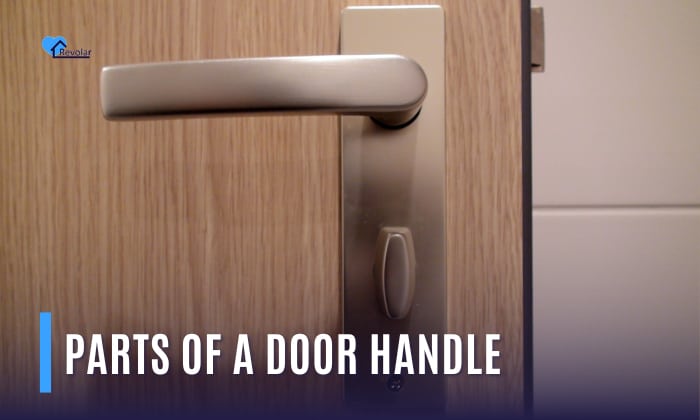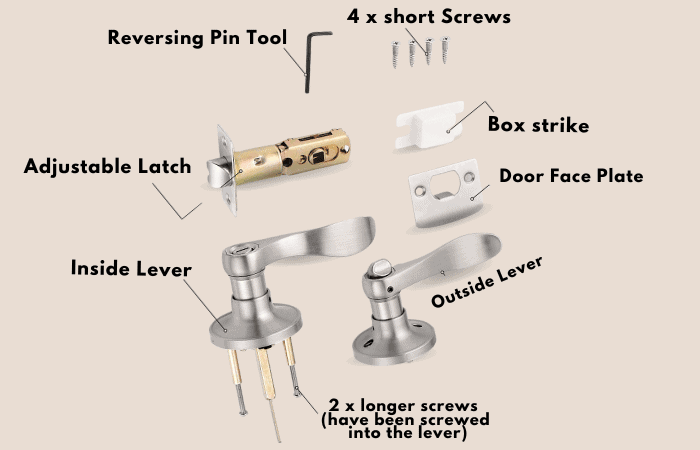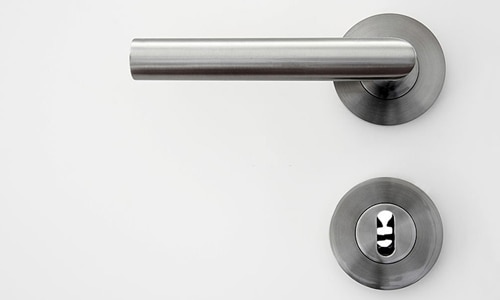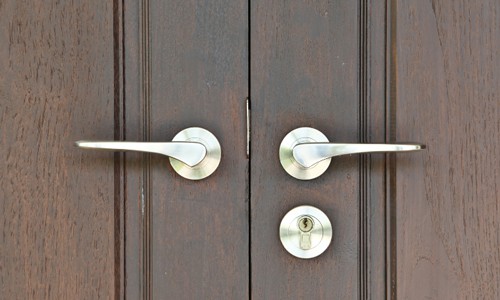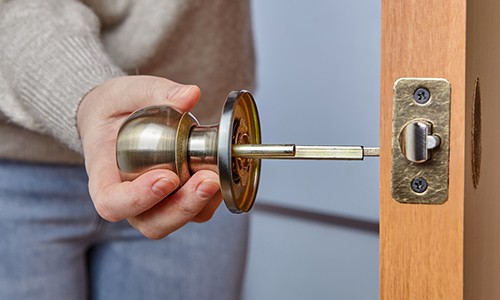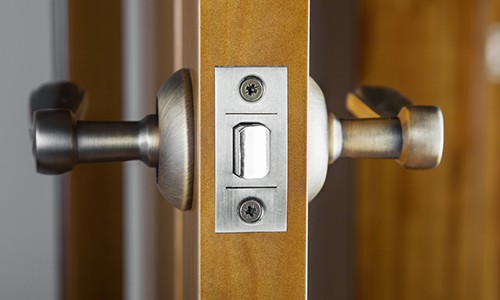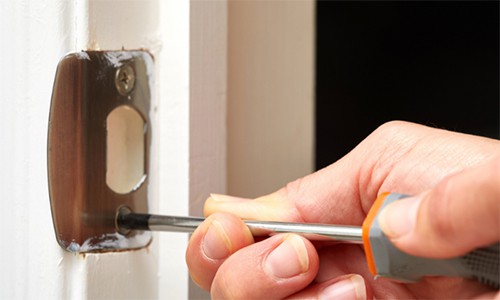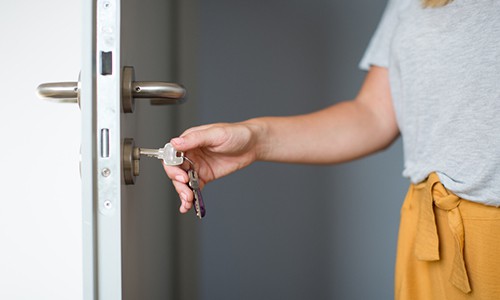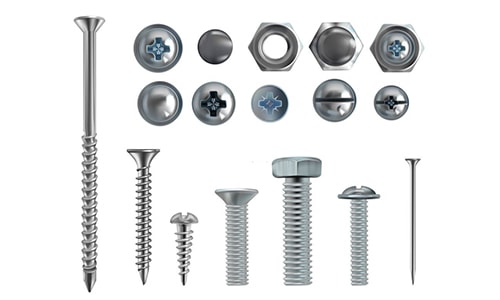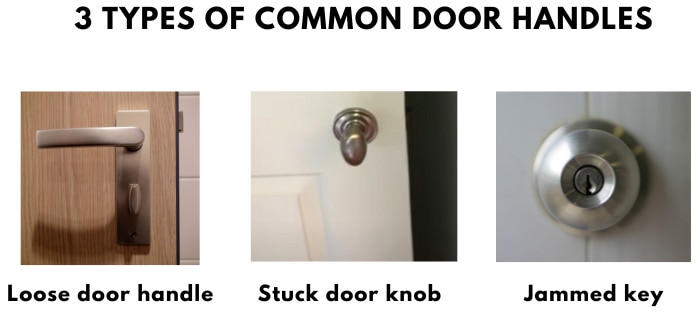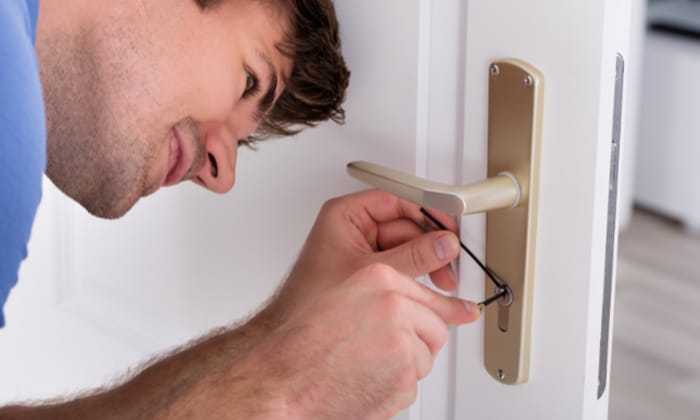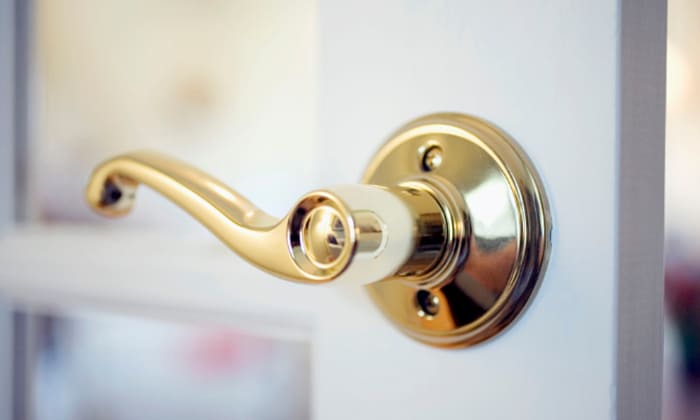Doors have been around forever. Where there’re doors, there’re handles to open them. Found on doors in homes, offices, and public buildings around the world, these simple yet versatile devices allow us to access spaces with ease, providing both security and convenience.
Door handles come in a wide variety of shapes and styles, but all possess the same fundamental mechanisms and components. In this article, we will break down the different parts of a door handle to show you how everything works under the surface.
Table of Contents
Door Handle Anatomy
A door handle parts diagram should help you visualize different parts of a door knob or handle and where they are located.
In case you’re still wondering “What are the parts of a door lock called and how do they work?”, read further into this article to find out.
1. Rosette or Backplate
One of the door handle components that we can notice right away is the rosette or the backplate. Both of these secure the door handle unto the door so that it won’t be wobbly and won’t fall off.
A circular plate is called a rosette and is responsible for covering any fittings of the door handle secured and hidden. Due to their design and clean look, rosettes are sometimes installed to add to the modern aesthetics of a home or a business.
On the other hand, backplates are rectangular plates that cover a larger area than the rosette. They are often found on doors with no built-in locks or doors with screw holes and marks that are unpleasant to look at. Backplates often go with traditional styles of homes or business buildings.
Depending on the manufacturer, they can be made of brass, bronze, steel, chrome, cast iron, or copper. If you want to be more aesthetic, you can also opt for a porcelain or glass rosette or backplate.
2. Lever or Knob
In the anatomy of a door handle, levers or knobs are essential. They control the turning of the spindle inside, which in turn, opens the door.
Because of its security and convenience, lever handles are mostly used for residential buildings. They are perfect handles for people with sweaty and oily hands, since they only need to push the lever handle down, which offers more grip compared to door knobs.
On the other hand, door knobs are mostly used for commercial purposes due to their modern and aesthetic look. To access the door, you need to grip the door knob with your hand and turn it clockwise, which would be difficult to access if your hands are wet.
Although brass is the most popular material to manufacture lever handles or door knobs, materials such as wood, plastic, ceramic, and glass are also used.
3. Spindle
One of the most important interior door handle parts is the spindle. The spindle is responsible for erecting and retracting the latch during and after the door handle is turned.
One end of the door spindle is attached to the inner door knob while the other is attached to the outer door knob. The spindle passes through the latch in the middle which retracts as soon as the door knob or handle is turned.
A spindle is made of metal, usually steel. The spindle often comes in two sizes: the 8mm for door handles and knobs and the 5mm for release locks and bathroom thumb turns.
4. Latch
The latch is responsible for opening and closing the door and is usually located inside of a door handle. The only visible part of the latch is the latch bolt, which enters the strike plate to keep the door closed, and retracts in order for the door to be opened.
The door latch contains a spring-loaded follower that pushes the latch bolt onto the strike plate if the lever or knob is turned. The follower goes back to its position if the lever or knob turns in the other direction.
Manufacturers often use aluminum, brass, iron, bronze, chrome, and stainless steel to make door latches. Commonly, the 64mm latch is used for lever door handles and the 76mm latch is used for door knobs.
5. Strike Plate
One of the pieces of a door handle that is usually found on the door jamb is the strike plate. The terminology comes from the purpose of the strike plate where it serves as the catching hole of the latch bolt when the door is closed and keeps the latch bolt in place.
Strike plates also improve the security of the door jamb, since most doors are made of wood. Even without turning or handling the door handle or knob, the strike plate can still guide the latch bolt onto the hole.
Strike plates are made of metal with a steel base.
6. Lock Cylinder
Door locks are ubiquitous in most residential or commercial buildings. They offer another layer of security as well as a sense of privacy. A lock cylinder is a component of a door lock that contains the locking mechanism.
Typically, a lock cylinder contains the locking pins, springs, and other components that enable the lock to operate. It can be operated using a key, which inserts into the cylinder and rotates the pins to align them with the shear line, allowing the cylinder to turn and the lock to open.
Lock cylinders can be made from various materials depending on the intended use and level of security required. Commonly, they’re made out of brass for residential buildings. Offices or high-security facilities may opt for lock cylinders manufactured from stronger metal like stainless steel or zinc alloy.
7. Screws
One of the door lever parts that should always be present is the screws. Based on the door lock parts names diagram, screws are responsible for fastening the parts onto the door so that they will not fall off.
Usually, most door knobs have two screws that piece the parts together. Some screws are exposed, while some are covered by the backplate.
Screws are usually made of steel. They can be bought from hardware stores in pairs.
The Types of Door Handles
Door handles differ in make, purpose, and function. There are three door handle types that we normally use:
-
When a lever handle is pushed down, the internal door lever parts rotate and unlock the door. Since a lever handle contains a spring mechanism, the lever handle goes back to its original position as soon as there is no force that is applied downwards to the handle.
- Pull handles
Pull handles are different from lever handles and door knobs since they do not have inner working mechanisms to close or open the door. Pull handles are usually installed on doors that do not have locks and that can be opened by just pushing or pulling.
They can be horizontal door handles if the door opens horizontally, or they can be vertical door handles if the door opens vertically.
- Door knobs
Because of its spherical shape, door knobs need to be grasped entirely with your hand so that you can open the door. Some door knobs can retract the door latch by turning the knob either clockwise or counterclockwise.
Common Problems with Door Handles
Like any other security measures, you can encounter problems with your door handles due to either wear and tear or because of incidents.
Here are some of the common problems with your door handle pieces:
-
- Loose door handle
A loose door handle can occur when the fittings and screws on the door handle are not properly fastened.
The signs of a loose door knob are when the door knob feels wobbly and/or you cannot open the door even when the lock is unlocked. To fix this, you have to get your screwdriver and tighten the screws on your assembly.
Accumulated rust or dirt inside the door knob can cause your door knob to get sticky or unable to move.
If you can see clumps of dirt or rusting, these might be the signs that you have a stuck door knob. In order for your door mechanism to get working again, you might want to pour or apply lubricant on the moving parts of your door handle.
- Jammed key
If you inserted your key and you can no longer get it out of the keyway, you now have a jammed key that needs to be removed.
This type of problem is usually common when your keys are dirty and rusty. However, applying lubricant should make it easier for you to pull out the jammed key.
Popular Door Handle Brands
If you are not sure what brand to buy your door handle from, here are some top door hardware names that you can try:
- Emtek: Emtek’s mix-and-match feature lets you design your own door handle, giving it more personality and adapting to your needs.
- Baldwin: You wouldn’t want to miss Baldwin’s estate door hardware category, which offers custom-made doors and door hardware that is on par with grand hotel aesthetics and make.
- Rejuvenation: If you are looking for a classic 19th-century look for your door handle, then Rejuvenation’s Benson Collection will surely suit your taste.
- Screwfix: If you are up for cheap but standard door handles, you might want to browse Screwfix’s door handle collection.
How do I Choose the Right Door Handle for My Home?
You might find yourself torn about which door handle to choose for your home. Before you grab an internal door handle from the shelf, you might want to consider the following aspects first:
- Decide what type of door handle you want to install. You can choose between door knobs which are great for aesthetic purposes or lever handles which boast convenience.
- Blend your door handle with your door and home’s aesthetics.
- Make sure that your door handle fits the hole of your door so that you won’t make any major adjustments to your door.
Conclusion
Every piece that improves the security inside and outside your home or business is crucial, thus you should be aware of how it works and how it can be maintained. If one of the components of a door handle is malfunctioning, it might be taken advantage of by people who want to rob you of your valuables and endanger your and your family’s security.
Knowing the parts of a door handle and how they work not only improves your knowledge but will also help you with diagnosing and fixing your door handle in times when you face door handle problems.

I am the last member to join Revolar and might be just the luckiest to work with dedicated people like Teddy and John. Our team has established a process where my only job is writing the best content to deliver incredible ideas and guides.


